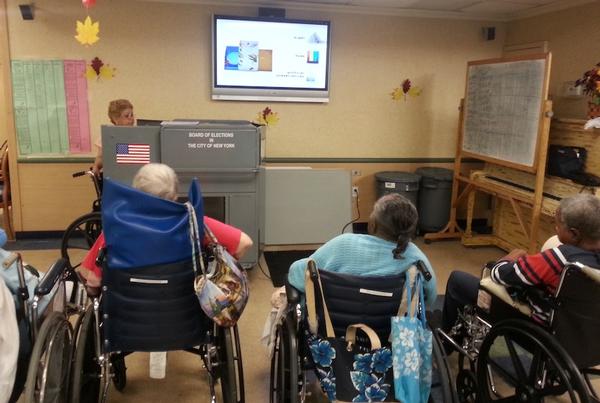
Photo by: Parker Brown
On Primary Day, disabled voters waited to cast their ballots at the Bronx Center for Rehabilitation and Healthcare in Soundview.
Ballot-marking devices have helped people vote independently, but some disabled voters say poll workers don’t know how to use them.
“Poll workers are not adequately trained on how to set up or use the machines,” says Julia Pinover, an attorney for Disability Rights Advocates, an organization that protects civil rights of disabled people. “So when people show up to vote and unfortunately the poll workers won’t have the requisite information about how the ballot-marking devices function.”
Greg Bell, a blind voter in the Bronx, says he uses the ballot-marking device every chance he gets and poll workers often don’t know how to set up the machines.
Bell, who is also the director of Insight for New Housing, a non-profit that focuses on affordable housing for the disabled community, was one of the people who tested and evaluated the ballot-marking devices when they were proposed, so he knew how the machine was supposed to be set up.
“They had the machine facing the wrong way so even though there was a shield around the machine, they were shielding me from a blank wall,” Bell says. “Anybody coming through the door could see what I was doing.”
Bell says the headphones were not set up right and the poll workers didn’t know how to work the machine. The ballot-marking devices are definitely a step forward for the disabled community, but don’t solve all the problems.
“It solves the issue of accessibility in terms of being able to express your vote, but it doesn’t solve the issue of accessibility in terms of the location of the polling site and the human problem,” Bell says. “How do you get these individuals that have been hired by the Board of Elections to be sensitive to people with disabilities?”
Before the ballot-marking device was introduced in New York City in 2010, disabled voters had to have an aide or poll worker go into the booth with them.
“For many adults it was the first time they could vote privately and independently,” says Margi Trapani, communications and education director of the Center for Independence of the Disabled, New York, a non-profit organization that advocates for independent living for people with disabilities. “We feel it’s a huge step forward in peoples’ ability to exercise their franchise.”
Karen Gourgey, a blind voter and director of the Computer Center for Visually Impaired People at Baruch College says her experience with the ballot-marking devices has been quite positive.
“They really do the job, as far as a person who is blind,” Gourgey says. “I am one of those people and within the last four years I had my first independent voting experience and I’m almost 60.”








